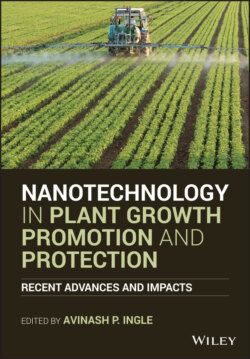Читать книгу Nanotechnology in Plant Growth Promotion and Protection - Группа авторов - Страница 54
3.3.2 Effects of Zn NPs on Plant Growth Promotion 3.3.2.1 Effects of Zn NPs Via Foliar Application
ОглавлениеThe aerial application of Zn NPs shows crop specie dependent effects at different concentration levels. Based on crop species the effective dose of Zn NPs varies (10–1000 mg/L) for foliar spray (Table 3.2). A study by Prasad et al. (2012) revealed that ZnO NPs at 1000 mg/L is the most effective dose for foliar spray in peanut, which provided the maximum positive effects on chlorophyll content, flowering, dry mass accumulation, plant height, and yield. ZnO NPs can be applied at 500 or 1000 mg/L as a precursor for tryptophan and biofortification agents to increase leaf yield and nutritional quality of spinach (Kisan et al. 2015). In peanut, maximum positive effects on flower initiation and chlorophyll content were observed at 1000 mg/L ZnO (25 nm) through the foliar spray at 35 and 70 days. In a recent study, ZnO NPs (12–24 nm) at 1000 mg/L yielded positive effects on Capsicum biomass, yield, and chlorophyll content, however, 2000 mg/L showed negative effects on plant biomass accumulation (García‐Gómez and Fernández 2019).
Figure 3.2 Translocation and major physiological and biochemical responses of Zn NPs in plants.
Additionally, Zn NPs can also be responsive at a very low concentration level. Typically, if the application concentration is reduced, then application time should be increased to obtain significant results (Table 3.2). Tarafdar et al. (2014) observed that 10 mg/L Zn NPs applied to pearl millet can substantially improve shoot length, root length, root area, chlorophyll content, total soluble leaf protein, plant dry biomass, and yield by 15.1, 4.2, 24.2, 24.4, 38.7, 12.5, and 37.7% respectively. Similarly, Rossi et al. (2019) got positive effects on coffee plants by application of ZnO NPs (15–20 nm) at 10 mg/L in 14 days intervals. But for maize, the optimal ZnO NPs (25 nm) foliar spray concentration was found to be 100 mg/L which provided maximum plant growth, production, and higher grain quality (Subbaiah et al. 2016). A study revealed that foliar application of ZnO NPs (18 nm) in onion, three times in each 15 day, promoted early crop growth from 10 to 30 μg/mL and enhanced early flowering with higher thousand seed weight up to 40 μg/mL (Laware and Raskar 2014). A study conducted in chickpea showed similar results, where the foliar spray (irrigated daily for 15 days) of ZnO NPs (20–30 nm) promoted dry matter production at 1.5 mg/L, but inhibited dry matter production at 10 mg/L (Burman et al. 2013).
Table 3.2 Effects of Zn NPs on plant growth and promotion applied through different application modes.
| Size and coatings (nm) | Crop | Concentrations | Mode of application | Effects | References | ||
|---|---|---|---|---|---|---|---|
| Root growth | Shoot growth | Yield | |||||
| 35.5 | Maize | 50–2000 mg/L | Foliar spray, two times (tasseling and milking stage) | + | + | + | Subbaiah et al. (2016) |
| 20 | Sunflower | 2000 mg/L | Foliar spray, two times (6 leaf stage and 1 week later), under salt stress (100 mM NaCl) | 0 | + | n/a | Torabian et al. (2018) |
| 20 | Coffee | 10 mg/L | Foliar spray (in 14 days interval) | + | + | n/a | Rossi et al. (2019) |
| 15–25 | Pearl Millet | 10 mg/L | Foliar spray (at 2 weeks and 4 weeks old) | + | + | n/a | Tarafdar et al. (2014) |
| <100 | Cotton | 100 and 200 mg/L | Foliar spray (3 weeks and 5 weeks old), under salt stress (irrigated with 10 and 20% sea water) | + | + | n/a | Hussein and Abou‐Baker (2018) |
| 20–30 | Chickpea | 1.5 ppm | Irrigated daily for 15 days | + | + | n/a | Burman et al. (2013) |
| 10 ppm | – | – | n/a | ||||
| 18 | Onion | 10–40 mg/L | Foliar spray (3 times at 15 days interval) | + | + | + | Laware and Raskar (2014) |
| 35 | Eggplant | 5–100 mg/L | Coco peat substrate treated with NPs | + | + | n/a | Thunugunta et al. (2018) |
| 10 | Cucumber | 400–800 mg/kg | Soil application | + | + | + | Zhao et al. (2014) |
| 10 | Kidney beans | 60–500 mg/kg | Spiked into soil | + | 0 | 0 | Medina‐Velo et al. (2017) |
| 10 | Green pea | 125–500, 2000 mg/kg | Spiked into soil | + | 0 | n/a | Mukherjee et al. (2014) |
| 10 | Soybean | 50, 100, and 500 mg/kg | Soil application | + | + | n/a | Priester et al. (2012) |
| 20–50 | Wheat | 250, 500, and 1000 mg/L | Petri plate and substrate treatment | + | + | + | Tarafdar et al. (2014) |
| 2000 mg/L | – | – | 0 | ||||
| 5 | Cotton | 25, 50, 75, 100, and 200 mg/L | Spiked into Hoagland media in hydroponic | + | + | n/a | Venkatachalam et al. (2017) |
| n/a | Tobacco | 0.2, 1, 5, and 25 μm | Spiked into soilless culture (hydroponic) | + | + | + | Tirani et al. (2019) |
